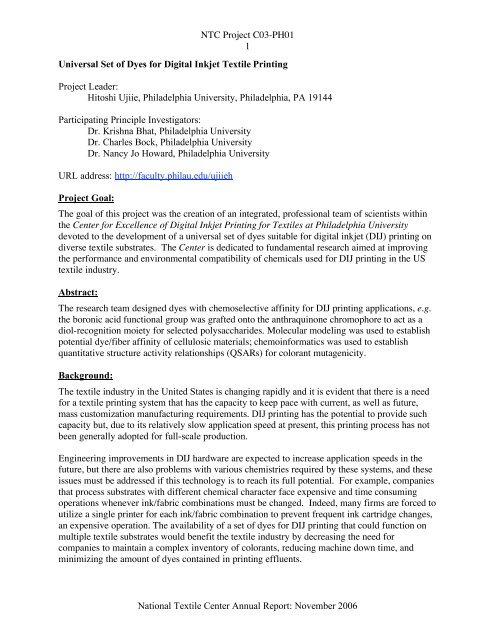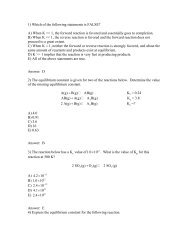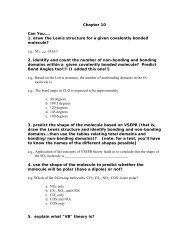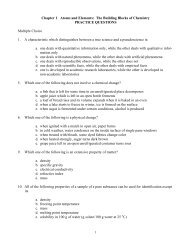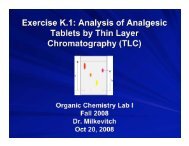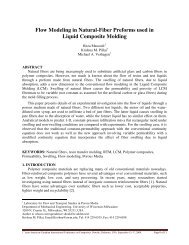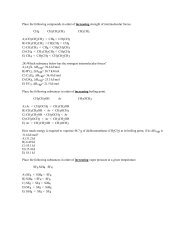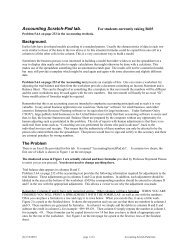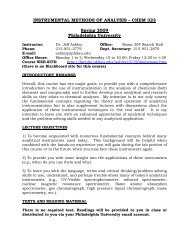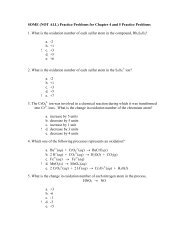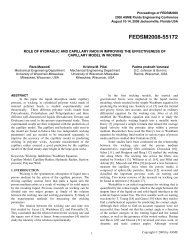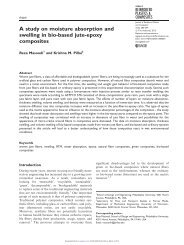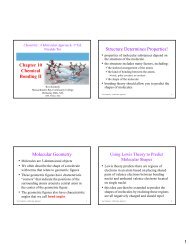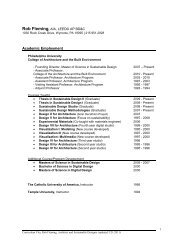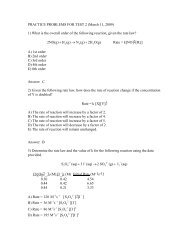Universal Set of Dyes for Digital Inkjet Textile Printing
Universal Set of Dyes for Digital Inkjet Textile Printing
Universal Set of Dyes for Digital Inkjet Textile Printing
You also want an ePaper? Increase the reach of your titles
YUMPU automatically turns print PDFs into web optimized ePapers that Google loves.
NTC Project C03-PH01<br />
1<br />
<strong>Universal</strong> <strong>Set</strong> <strong>of</strong> <strong>Dyes</strong> <strong>for</strong> <strong>Digital</strong> <strong>Inkjet</strong> <strong>Textile</strong> <strong>Printing</strong><br />
Project Leader:<br />
Hitoshi Ujiie, Philadelphia University, Philadelphia, PA 19144<br />
Participating Principle Investigators:<br />
Dr. Krishna Bhat, Philadelphia University<br />
Dr. Charles Bock, Philadelphia University<br />
Dr. Nancy Jo Howard, Philadelphia University<br />
URL address: http://faculty.philau.edu/ujiieh<br />
Project Goal:<br />
The goal <strong>of</strong> this project was the creation <strong>of</strong> an integrated, pr<strong>of</strong>essional team <strong>of</strong> scientists within<br />
the Center <strong>for</strong> Excellence <strong>of</strong> <strong>Digital</strong> <strong>Inkjet</strong> <strong>Printing</strong> <strong>for</strong> <strong>Textile</strong>s at Philadelphia University<br />
devoted to the development <strong>of</strong> a universal set <strong>of</strong> dyes suitable <strong>for</strong> digital inkjet (DIJ) printing on<br />
diverse textile substrates. The Center is dedicated to fundamental research aimed at improving<br />
the per<strong>for</strong>mance and environmental compatibility <strong>of</strong> chemicals used <strong>for</strong> DIJ printing in the US<br />
textile industry.<br />
Abstract:<br />
The research team designed dyes with chemoselective affinity <strong>for</strong> DIJ printing applications, e.g.<br />
the boronic acid functional group was grafted onto the anthraquinone chromophore to act as a<br />
diol-recognition moiety <strong>for</strong> selected polysaccharides. Molecular modeling was used to establish<br />
potential dye/fiber affinity <strong>of</strong> cellulosic materials; chemoin<strong>for</strong>matics was used to establish<br />
quantitative structure activity relationships (QSARs) <strong>for</strong> colorant mutagenicity.<br />
Background:<br />
The textile industry in the United States is changing rapidly and it is evident that there is a need<br />
<strong>for</strong> a textile printing system that has the capacity to keep pace with current, as well as future,<br />
mass customization manufacturing requirements. DIJ printing has the potential to provide such<br />
capacity but, due to its relatively slow application speed at present, this printing process has not<br />
been generally adopted <strong>for</strong> full-scale production.<br />
Engineering improvements in DIJ hardware are expected to increase application speeds in the<br />
future, but there are also problems with various chemistries required by these systems, and these<br />
issues must be addressed if this technology is to reach its full potential. For example, companies<br />
that process substrates with different chemical character face expensive and time consuming<br />
operations whenever ink/fabric combinations must be changed. Indeed, many firms are <strong>for</strong>ced to<br />
utilize a single printer <strong>for</strong> each ink/fabric combination to prevent frequent ink cartridge changes,<br />
an expensive operation. The availability <strong>of</strong> a set <strong>of</strong> dyes <strong>for</strong> DIJ printing that could function on<br />
multiple textile substrates would benefit the textile industry by decreasing the need <strong>for</strong><br />
companies to maintain a complex inventory <strong>of</strong> colorants, reducing machine down time, and<br />
minimizing the amount <strong>of</strong> dyes contained in printing effluents.<br />
National <strong>Textile</strong> Center Annual Report: November 2006
Approach:<br />
NTC Project C03-PH01<br />
2<br />
A multi-disciplinary approach was used in this project: the team consisted <strong>of</strong> an organic chemist,<br />
textile chemist, computational chemist and a DIJ specialist. Developing dyes that exhibited<br />
chemoselective affinity <strong>for</strong> specific textile substrates was a <strong>for</strong>midable task because <strong>of</strong> the<br />
hydrophobic nature <strong>of</strong> some substrates (e.g. polyester, nylon) and the polar or ionic nature <strong>of</strong><br />
others (e.g. cotton, silk). The core idea in this project was to incorporate chemical-sensor<br />
subgroups onto chromophores that would serve as affinity ligands and effectively distinguish<br />
between different substrate functional groups. This type <strong>of</strong> approach has proved to be beneficial<br />
in medicinal chemistry [1], but has not been explored in the context <strong>of</strong> textile chemistry.<br />
A practical synthetic methodology was developed in the first year <strong>of</strong> this project that<br />
incorporated azo-functionality onto an anthraquinone chromophore to provide extended<br />
conjugation (Schemes 1, 2 and Figure 1).<br />
Scheme 1. Synthesis <strong>of</strong> anthraquinone dyes containing azo linkages synthesized from 1-<br />
aminoanthraquinone.<br />
Scheme 2. Synthesis <strong>of</strong> an anthraquinone dye containing boronic acid functionality.<br />
National <strong>Textile</strong> Center Annual Report: November 2006
NTC Project C03-PH01<br />
3<br />
Figure 1. Structures <strong>of</strong> Selected Anthraquinone <strong>Dyes</strong> from Molecular Modeling.<br />
This chemistry in Scheme I and 2, which is amenable to automation, was demonstrated in the<br />
synthesis <strong>of</strong> several compounds containing this novel azo-anthraquinone skeleton. All the new<br />
compounds generated via this synthetic route were thoroughly characterized by physical data,<br />
see Table 1. Technical textile properties, e.g. lightfastness, washfastness, and substantivity, were<br />
assessed by conventional procedures, see Table 2.<br />
Compound<br />
Yield<br />
(%)<br />
Melting<br />
Point (˚C)<br />
λ max<br />
(nm)<br />
UV (Methanol)<br />
Log ε<br />
2 65 228-229 475 3.45<br />
3 80 239-240 430 3.84<br />
4 78 242-243 410 3.18<br />
5 65 237-238 472 3.18<br />
6 70 230-231 470 3.43<br />
NMR (δ)<br />
3.5(2H, s), 6.5-6.7(4H, m), 7.3-<br />
8.1(7H, m)<br />
3.1(6H, s), 6.6-6.8(4H, m), 7.4-<br />
8.1(7H, m)<br />
5.8(1H, s), 6.9-7.1(4H, m), 7.4-<br />
8.2(7H, m)<br />
3.8(3H, s), 6.8-7.2(4H, m), 7.4-<br />
8.2(7H, m)<br />
7.2-7.5(4H, m), 7.6-7.7(2H, m), 7.8-<br />
8.2(7H, m)<br />
Elemental Analysis<br />
Found (Calculated)<br />
C H N B<br />
73.30<br />
(73.38)<br />
74.27<br />
(74.35)<br />
73.61<br />
(73.67)<br />
73.12<br />
(73.16)<br />
67.50<br />
(67.45)<br />
4.01<br />
(4.06)<br />
4.77<br />
(4.82)<br />
4.05<br />
(4.12)<br />
3.63<br />
(3.68)<br />
3.70<br />
(3.68)<br />
12.78<br />
(12.84)<br />
11.05<br />
(11.82)<br />
8.11<br />
(8.18)<br />
8.48<br />
(8.53)<br />
7.90<br />
(7.87)<br />
3.00<br />
(3.04)<br />
Table 1. Physical Data <strong>for</strong> Compounds in Scheme 1.<br />
Washfastness*<br />
Lightfastness** (20 hr & 40 hr exposure)<br />
Dye<br />
Polyester Nylon Cotton Silk<br />
Polyester Nylon Cotton Silk<br />
20hr 40hr 20hr 40hr 20hr 40hr 20hr 40hr<br />
2 5 4 1 2 5 3-4 3 2-3 5 5 3 2-3<br />
3 5 5 1 2 4-5 3-4 3-4 3-4 5 4-5 3 2<br />
4 5 5 1 1-2 4 3 2-3 3 5 5 3-4 3<br />
5 5 5 1 2 4-5 3-4 3-4 2 5 5 3 2-3<br />
*Washfastness AATCC Test Method 61-1996 (Test No.2A)<br />
**Lightfastness AATCC Test Method 16-1998<br />
Table 2. Washfastness and Lightfastness <strong>of</strong> <strong>Dyes</strong> 2 – 5.<br />
National <strong>Textile</strong> Center Annual Report: November 2006
NTC Project C03-PH01<br />
4<br />
One thrust <strong>of</strong> this project in the first year was to determine the extent to which boronic acid<br />
functionality introduced into anthraquinone and/or azo dyes, enabled the binding <strong>of</strong> the resultant<br />
dye to cellulosic textile materials; computational chemistry was employed <strong>for</strong> this purpose.<br />
Boronic acids are known to <strong>for</strong>m borate complexes with saccharides containing diol moieties<br />
with a high degree <strong>of</strong> cis/trans specificity [2,3]. Calculations at the B3LYP/6-311++G** and<br />
MP2/6311++G** levels were carried out to establish the thermodynamics and kinetics <strong>of</strong> the<br />
<strong>for</strong>mation <strong>of</strong> a typical boron-oxygen-carbon (B-O-C) bond.<br />
In the first year, the <strong>for</strong>mation <strong>of</strong> a B-O-C linkage was studied using the dehydration reaction,<br />
H 2 B(OH) + H 3 C-OH H 2 B-O-CH 3 + H 2 O,<br />
as a model. It was shown that the process was initiated by a nucleophilic attack <strong>of</strong> the hydroxyl<br />
oxygen on the electron deficient boron atom <strong>of</strong> the reactant H 2 B(OH). This reaction was<br />
predicted to proceed rather slowly. However, a proton transfer was involved in this process, and<br />
it was established that an external Lewis base, such as ammonia, improved the kinetics <strong>of</strong> the<br />
reaction [4].<br />
In the second year our experimental ef<strong>for</strong>ts were expanded to incorporate two binding sites on<br />
the dyes being synthesized. In addition to the boronic acid moiety, we initially incorporated a<br />
reactive guanidinium moiety on the dye framework. The cationic nature <strong>of</strong> the guanidinium<br />
group was expected to enhance both the solubility properties <strong>of</strong> the dyes and improve<br />
electrostatic interactions with ionic substrates. The power <strong>of</strong> including a guanidinium group <strong>for</strong><br />
the binding <strong>of</strong> anionic guest molecules in competitive media has been demonstrated [5].<br />
Synthesizing such dyes with two reactive groups proved to be quite challenging, but we<br />
eventually developed a methodology to incorporate the guanidinium group onto an anthracene<br />
unit in a single step, using a modified version <strong>of</strong> the Mitsunobu reaction, Scheme 3 [6]. Since<br />
the use <strong>of</strong> solid supports to facilitate combinatorial synthesis has become a popular way <strong>of</strong><br />
generating libraries <strong>of</strong> new compounds with desired properties, we also extended our procedure<br />
to include the use <strong>of</strong> polymer supported reagents as a means <strong>of</strong> facilitating purification.<br />
DEAD, Ph 3 P in Toluene<br />
N,N' di Boc-guanidine<br />
H 2C<br />
OH<br />
H 2C<br />
N<br />
C<br />
NH 2<br />
Boc<br />
N<br />
Boc<br />
Scheme 3. Synthesis <strong>of</strong> a guanidinium moiety using the Mitsunobu reaction.<br />
In the second year calculations were per<strong>for</strong>med on a system in which an internal Lewis base<br />
could expedite the <strong>for</strong>mation <strong>of</strong> a B-O-C linkage. Specifically, we investigated the<br />
thermodynamics and the kinetics <strong>of</strong> the reaction,<br />
H 2 N-CH 2 -CH=CH-B(OH) 2 + H 3 C-OH H 2 N-CH 2 -CH=CH-B(OCH 3 )(OH) + H 2 O,<br />
in which the amino group acted as an internal Lewis base. We showed that when this amino<br />
group was appropriately positioned, it lowered the activation barrier <strong>for</strong> the <strong>for</strong>mation <strong>of</strong> product<br />
National <strong>Textile</strong> Center Annual Report: November 2006
NTC Project C03-PH01<br />
5<br />
[7]. These results guided us to develop synthetic techniques designed to graft a variety <strong>of</strong> Lewis<br />
bases onto our molecular framework in the vicinity <strong>of</strong> the boronic acid moiety.<br />
Calculations in the second year <strong>of</strong> the project were per<strong>for</strong>med on the second step in the boronic<br />
acid-diol complexation reaction; ethylene glycol was used in place <strong>of</strong> methanol resulting in the<br />
<strong>for</strong>mation <strong>of</strong> a second B-O-C linkage. A 5-membered cyclic ester, HB(-O-CH 2 -CH 2 -O-), was<br />
generated via the reaction,<br />
HB(OH) 2 + HOCH 2 -CH 2 OH HB(-O-CH 2 -CH 2 -O-) + 2H 2 O.<br />
In the absence <strong>of</strong> any catalysts, the activation barriers <strong>for</strong> both steps involved in this reaction<br />
were rather high and the reaction was predicted to proceed rather slowly.<br />
The need to develop dyes with minimal adverse genotoxic behavior was also addressed<br />
computationally during the second year using semi-empirical quantum chemical methodology.<br />
Quantitative structure–activity relationships (QSARs) were developed <strong>for</strong> the mutagenicity <strong>of</strong> a<br />
variety <strong>of</strong> azo dyes. This has been accomplished within the context <strong>of</strong> the largest database <strong>of</strong><br />
amino compounds <strong>for</strong> which the mutagenicity has been measured that has ever been assembled –<br />
over 180 amino derivatives are currently in the database. Multilinear regression techniques were<br />
shown to account <strong>for</strong> approximately 66% <strong>of</strong> the observed mutagenic behavior <strong>of</strong> the compounds<br />
and artificial neural network (ANN) approaches, in conjunction with fuzzy logic, [8] accounted<br />
<strong>for</strong> more than 90% <strong>of</strong> the variation. These QSARs provide a preliminary screening device <strong>for</strong><br />
new dyes.<br />
During the third year <strong>of</strong> this project synthetic difficulties required us to look <strong>for</strong> alternatives to<br />
the inclusion <strong>of</strong> the guanidinium moiety. In particular, we considered non-aromatic nitrogenous<br />
structures with the capacity to <strong>for</strong>m the intramolecular 5-membered ring, 7-membered ring, or<br />
Zwitterions when proximal to a boronic acid moiety shown below.<br />
H 2<br />
C<br />
N<br />
CH 3<br />
R<br />
B<br />
O<br />
B<br />
HO<br />
HO<br />
OH<br />
5-membered ring 7-membered ring HO<br />
Zwitterion<br />
H 2<br />
C<br />
CH 3<br />
R H 2<br />
N<br />
C<br />
H<br />
B<br />
OH<br />
NH<br />
OH<br />
R<br />
CH 3<br />
Our initial synthetic ef<strong>for</strong>ts focused on synthesizing binding sites at the 9,10 positions <strong>of</strong> the<br />
anthracene chromophore that would facilitate Lewis acid-base intramolecular interaction<br />
between nitrogen and boron. The first route utilized a two-step reduction [9] <strong>of</strong> the di-functional<br />
aldehyde, 9,10 anthracene dicarboxaldehyde, followed by reaction <strong>of</strong> the resultant imine with a<br />
primary amine, α-methylbenzylamine, using sodium borohrydride (NaBH 4 ) to produce a reactive<br />
iminium ion. The subsequent reaction with 2,4,6-tris[o-(bromomethyl) phenyl]boroxine<br />
(“boroxin”) produced the di-functional boronic acid moieties. Isolation, purification, and<br />
characterization <strong>of</strong> the intermediates and product proved to be very difficult.<br />
A one-step synthesis <strong>of</strong> similar compounds was explored using the cyanohydridoborate anion<br />
(BH 3 CN - ), which selectively reduced aldehyde and imine functional groups, Scheme 4 [10].<br />
Careful adjustment <strong>of</strong> pH and temperature provided a means <strong>of</strong> controlling undesirable,<br />
competing side reactions. The di-functional aldehyde, 9,10 anthracene dicarboxaldehyde, and a<br />
National <strong>Textile</strong> Center Annual Report: November 2006
NTC Project C03-PH01<br />
6<br />
mono-functional aldehyde, 9-anthraldehyde, in combination with methylamine, were reacted<br />
under similar conditions. Although the one-pot process was attractive <strong>for</strong> use in combinatorial<br />
syntheses, excessive reaction time [72-96 hours], and production <strong>of</strong> toxic hydrogen cyanide gas<br />
as a by-product, made this synthetic route undesirable.<br />
H 3C<br />
N<br />
O<br />
H<br />
H<br />
HN<br />
CH 3<br />
H<br />
NaBH 3 CN<br />
CH 2<br />
CH 3<br />
CH 2<br />
boroxin<br />
CH3CN<br />
K 2 CO 3<br />
Reflux<br />
B(OH) 2<br />
C<br />
H 2<br />
N<br />
Scheme 4. One-step reductive amination using the cyanoborohydride followed by a reaction<br />
with boronic acid anhydride.<br />
A one-step reductive amination reaction conducted using triacetoxyborohydride provided a safer<br />
alternative, Scheme 5 [11]. The reducing agent converted stoichiometric amounts <strong>of</strong> the<br />
dicarboxaldehyde and 1 º amine (methyl amine or α-methylbenzylamine) to the corresponding 2 º<br />
amines in high yields, requiring a much shorter reaction time [20 min.- 2 hr.], while producing<br />
only small amounts <strong>of</strong> benign by-products. Due to the high reactivity <strong>of</strong> the free amines, an<br />
oxygen-free environment was required throughout the reduction reaction. Stable ammonium<br />
chloride salts were isolated, and purification and characterization are currently being carried out.<br />
It was anticipated that, by maintaining an oxygen-free environment, the reaction with 2,4,6-<br />
tris[o-(bromomethyl)phenyl] boroxine can be conducted immediately following the reductive<br />
amination without the HCl salt <strong>for</strong>mation.<br />
CH 3<br />
H 3C<br />
Ph<br />
Ph<br />
CH<br />
N<br />
H<br />
O<br />
H<br />
H<br />
CH<br />
HN<br />
CH 2<br />
H 3C<br />
Ph<br />
CH<br />
N<br />
H 2<br />
C<br />
(HO) 2B<br />
H<br />
HB(OAc) 3 Na<br />
DCE<br />
H 2C<br />
boroxin<br />
CH3CN<br />
K 2 CO 3<br />
Reflux<br />
CH 2<br />
B(OH) 2<br />
C<br />
H 2<br />
H 2C<br />
N<br />
Ph<br />
CH<br />
CH 3<br />
H<br />
H<br />
O<br />
N<br />
Ph<br />
Amine<br />
NH<br />
CH<br />
CH 3<br />
Ph CH 3<br />
Scheme 5. One-step reductive amination using the triacetoxyborohydride followed by a reaction<br />
with boronic acid anhydride.<br />
Computationally in the third year we focused on studies designed to elucidate the<br />
thermochemistry <strong>of</strong> the reaction between phenylboronic acid (PBA) and a sinple model<br />
cellulosic substrate. The initial model <strong>of</strong> cellulose chosen <strong>for</strong> this study, C 1 , was a singlestranded<br />
molecule composed <strong>of</strong> four repeating anhydroglucose units. The structure <strong>of</strong> this<br />
molecule was optimized using density functional theory (DFT) at the LDA/6-31G* (B3LYP/6-<br />
31G*) computational levels with the Spartan s<strong>of</strong>tware package from Wavefunction Inc. [12], see<br />
Figure 2. The initial geometry <strong>for</strong> the optimization was chosen to incorporate the expected<br />
intramolecular hydrogen bonding [13], whereas intermolecular hydrogen bonding between<br />
different strands in cellulose was completely ignored in these investigations.<br />
National <strong>Textile</strong> Center Annual Report: November 2006
NTC Project C03-PH01<br />
7<br />
Figure 2: Model Cellulosic Substrate.<br />
Two models <strong>for</strong> the product <strong>of</strong> a dehydration reaction <strong>of</strong> this cellulose molecule and PBA were<br />
investigated. This dehydration is the primary reaction required to bind a dye, designed with<br />
boronic acid functionality, to a cellulosic substrate. The first model product, P 1 , employed the<br />
2,6’-hydroxyl groups <strong>of</strong> the model substrate, see Figure 3; it involves hydroxyl groups on two<br />
different adjacent glucose units. The second model, P 2 , employed two hydroxyl groups on the<br />
same glucose unit that are in a 2,3 cis arrangement, see Figure 4.<br />
Figure 3: Hydration product, P 1 , involving the 2,6’-hydroxyl groups.<br />
Figure 4: Hydration product, P 2 , involving the 2,3-hydroxyl groups (cis).<br />
Interestingly, the structure <strong>of</strong> P 1 is 8.4 kcal/mol lower in energy than P 2 at the LDA/6-31G*<br />
computational level, whereas these two rather different structures have nearly the same energy at<br />
the higher-level B3LYP/6-31G* computational level, see Table 3.<br />
National <strong>Textile</strong> Center Annual Report: November 2006
NTC Project C03-PH01<br />
8<br />
Reaction<br />
ΔE(kcal/mol)<br />
C 1 + PBA → P 1 +2H 2 O +23.4 (21.5)<br />
C 1 + PBA → P 2 +2H 2 O +31.8 (20.1)<br />
Table 3: Dehydration reaction energetics <strong>for</strong> a model boronic acid dye-cellulose complex.<br />
For comparison, calculated reaction thermodynamics <strong>for</strong> the <strong>for</strong>mation <strong>of</strong> a single B-O-C linkage<br />
in the dehydration reaction:<br />
H 2 N-CH 2 -CH=CH-B(OH)H + H 3 C-OH → H 2 N-CH 2 -CH=CH-B(OCH 3 )H + H 2 O<br />
are essentially thermoneutral: ΔH o 298 = -0.2 kcal/mol at the MP2(FULL)/6-311++G**<br />
//B3LYP/6-311++G** level [7].<br />
Acknowledgements<br />
The PI wishes to thank graduate students Pavani Nandula, Ravneet, Amadeep Randhawa and the<br />
undergraduate student Heather Vodzak.<br />
References:<br />
1. Yang, W., Gao, X., Wang, B., Med. Res. Reviews (2003) 23, 346.<br />
2. Springsteen, G. and B.Wang, Tetrahedron (2002) 58, 5291.<br />
3. Pawlowski, N. E., D.D. Russell and K.M. Robotti, USP 5,108,502 (April 28, 1992).<br />
4. Bhat, K.L., Hayik, S. & Bock, C.W., J. Mol. Struct (Theochem) (2003) 638, 107.<br />
5. Best, M.D., S.L. Tobey and E.V. Anslyn, Coordination Chemistry (2003) 240, 3.<br />
6. Yang, Y., B. Wang, Chem Comm (2003) 792.<br />
7. Bhat, K.L., Braz, V., Laverty, E. & Bock, C.W., J. Mol. Struct (Theochem) (2004) 712, 9.<br />
8. Bhat, K.L., S. Hayik, L. Sztandera & C.W. Bock, Chem Info & Comp Sci (2004) submitted.<br />
9. Ward, C.J., P. Patel, P.R. Ashton and T. James, Chem Commun (2000) 229-230.<br />
10. Borch R.F., M.D. Bernstein and H.D. Durst, JACS (July 16, 1971) 93(12), 2897-2904.<br />
11. Abdel-Magid, A., K.G. Carson, B.D. Harris, C.A. Maryan<strong>of</strong>f and R.D. Shah, J. Org. Chem.<br />
(1996) 61, 3849-3862.<br />
12. Spartan ’02, Wavefunction, Inc., 18401 Von Karman Avenue, Suite 370, Irvine, CA 92612<br />
USA.<br />
13. Sturcova, A., I. His, T.J. Wess, G. Cameron, M.C. Jarvis, Biomacromolecules (2003) 4,<br />
1589.<br />
National <strong>Textile</strong> Center Annual Report: November 2006


